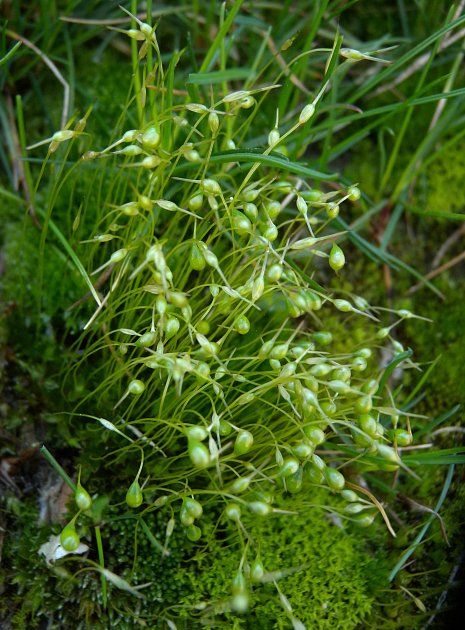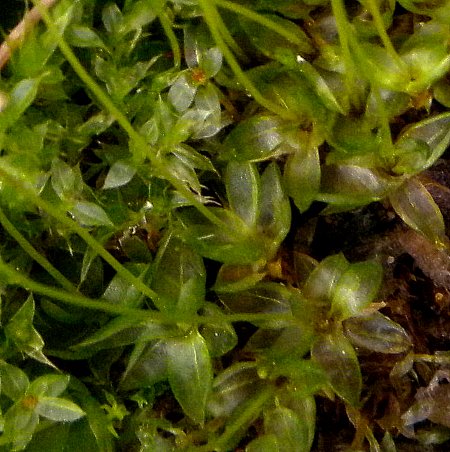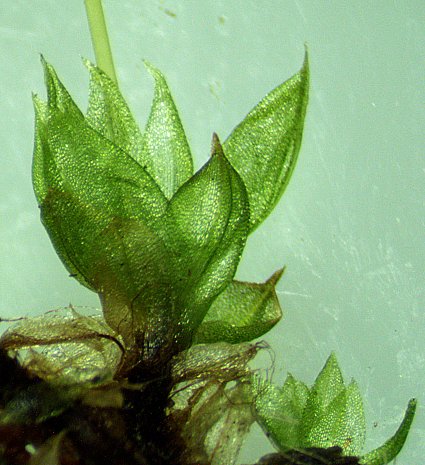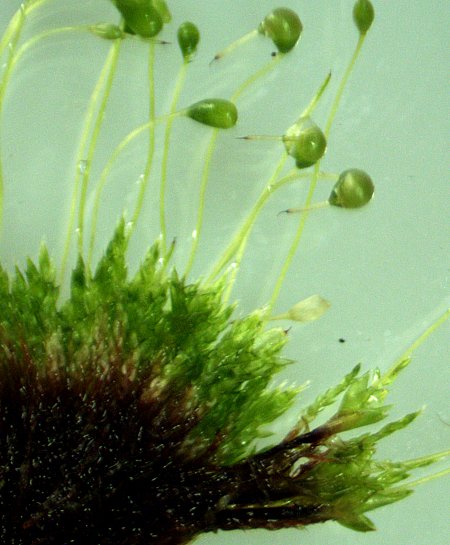
At the apex of each immature capsule, there is a low domed-conical lid (operculum) that covers its slightly oblique mouth. There is also a membranous hood (calyptra) with a long narrow beak that covers the lid and upper part of the capsule. The beak of the hood is as long as the capsule or a little longer; it often points sideways or downward. The hood falls off the capsule while it is still green and immature. As the capsule matures, it develops a yellow ring underneath its lid. At maturity, the entire capsule becomes red, more cylindrical in shape, and shriveled; its exposed mouth becomes very oblique, facing downward. Surrounding the mouth of a mature capsule, there is a ring of red outer teeth (peristome teeth); these teeth bend inward to partially close the mouth. The outer teeth are linear-lanceolate in shape and their margins are minutely bumpy (papillose) from the extension of their numerous cross-sections. There is also a ring of inner teeth (endostome segments) at the mouth of the capsule. These inner teeth are yellow and linear-lanceolate in shape; they are about two-thirds of the length of the outer teeth. The spores of the capsule are readily distributed by the wind; this normally occurs from late spring to mid-summer. Individual spores are 20–25 micrometers in diameter, globoid in shape, smooth-surfaced, and yellow. Slender brownish rhizoids anchor this moss to the ground at its base. This moss often forms colonies.

Cultivation: The preference is full sun to light shade and moist to dry conditions. Any kind of substrate is tolerated, including loam, sand, and gravel. Rocks and logs are normally not acceptable unless they are covered with a thin layer of decayed organic material. Most growth and development occurs during the cool moist weather of spring. Spore-bearing capsules are freely produced. This moss can be cultivated in greenhouses, although it has the potential to become a weedy pest.

Range & Habitat: The native Bonfire Moss (Funaria hygrometrica) has been collected in all areas of Illinois, except the southwestern section of the state (see Distribution Map). This common weedy moss probably occurs in every county of the state. It is widely distributed in North America, Eurasia, South America, and Australia. In Illinois, this moss has been found on thin soil covering limestone rocks, sandstone walls, sandy hills, sand dunes along Lake Michigan, clay banks along streams, ground soil in woods, discarded mortar of old ruined buildings, crevices of old buildings, bricks of houses in moist shady areas, piles of dredged material from rivers, piles of shale, old logs in brush piles, cracks between bricks in patios, cracks of concrete dams, gravelly sand in quarries, crevices in north-facing walls that are made from cloth bags of dirt, abandoned campfire sites, burned-over ground, roadsides, areas along railroads (including the gravelly ballast), the interior of greenhouses, pastures, fallow fields, and waste ground. Disturbed areas are strongly preferred, especially where some kind of fire has occurred.

Faunal Associations: Information is limited. Land slugs (Arionidae) feed on the protonemata (fibrous mat stage of newly germinated mosses), young leafy shoots, and immature spore capsules of Bonfire Moss (Funaria hygrometrica); see Davidson et al. (1990). This moss is a source of food for the Bobwhite Quail in southeast USA (Robinson & Barkalow, 1979).
Photographic Location: A north-facing wall along an embankment that was constructed from cloth bags containing dirt in Urbana, Illinois. Some photographs were taken indoors with the camera of a microscope.

Comments: Bonfire Moss (Funaria hygrometrica) is one of the earliest mosses to develop leafy shoots and spore capsules during the spring. This moss is fairly easy to identify when its spore capsules are produced because of their unique shape and oblique mouths. At sunny sites, it can become quite colorful before withering away underneath the hot summer sun. While there are other Funaria spp. in Illinois, Bonfire Moss is by far the most common. One such species that occurs in Illinois is Funaria flavicans. This latter moss can be distinguished from Bonfire Moss by the less oblique mouth of its spore capsules and the shorter length of the inner teeth at the mouth of such capsules. The inner teeth of Funaria flavicans are only one-third of the length of the outer teeth, while the inner teeth of Bonfire Moss are two-thirds of the length of the outer teeth. Another species, Funaria americana, can be distinguished by its shorter stalks (setae), typically about 6–10 mm. in length, and shorter spore capsules (1.5–2 mm. in length). Other common names of Funaria hygrometrica include Cinderella Moss and Cord Moss.